The underground movement that came to be known as grunge is quite possibly the only musical scene that dictated a fashion trend while actively pursuing the exact opposite.
Nirvana didn’t singlehandedly upend the rock world with Nevermind and unwittingly unleash alternative music onto the American charts and beyond, as brilliant as they were. While no one was expecting Nirvana to kick Michael Jackson off the Billboard 200 top spot, major label eyes were firmly affixed on Seattle and the broader indie world, even by the end of the 1980s. Before Nirvana’s explosive sophomore, Alice in Chains, Soundgarden, and Pearl Jam all had albums out and were enjoying relative success.
But Kurt Cobain’s accidental style thrust mainstream perceptions of what the grunge aesthetic would forever be defined as. Typically sporting a band T-shirt, ripped jeans, and a flannel shirt or a low-key cardigan, reflected the working-class makeup of Washington state’s previously sleepy logging city, a wardrobe largely informed by economy and practicality over calculated efforts at ‘looking’ DIY.
The loose and baggy thrift-store style was a natural response to the fashion trends of the day. Long after punk’s original impact, a breed of flashy hair-metal buffoonery mugging for MTV’s attention became the uniform of rock. Even former Black Sabbath frontman Ozzy Osbourne suddenly slapped on peroxide hair and sequined jackets during his solo pomp. The gloss that had robbed rock of its soul was shunned in the punk underground, embracing a get-up that flexed ‘normality’ as much as possible in the face of Mötley Crüe’s comic book preen.
Never mind that some of grunge’s biggest names hid hair metal skeletons in their closet—Alice in Chains previously Alice N’ Chains with much bigger barnets before refocusing their sound—but Seattle’s explosive years as alternative rock’s global capital unwittingly ushered in a new look for a new decade; a dress that matched the whole scene’s coveted veneration of authenticity over the superficial that had clogged popular culture throughout much of their teens.
Yet, as ever, capitalism’s ever-flexible and responsive forces swiftly swooped in and twisted grunge’s homespun and subdued flair into the era’s ‘uniforme de rigueur’. Alanis Morissette and Linda Perry were authentically wrapped in oversized jumpers and leather boots, but did anyone believe Kiss’ new grizzled and goateed dress down for 1997’s Carnival of Souls: The Final Sessions after a decade of ‘Lick It Up’ and ‘Crazy, Crazy Nights’?
Before long, grunge moved from a genre to become the season’s hottest look, with everybody from Calvin Klein, Versace, and Saint Laurent organising grunge-themed catwalks, eager to flaunt their high-end fashion cosplaying as indie counterculture. Deals could be found in malls across the country, spelling grunge’s final pull into the commodified world.
It’s a curious contradiction. A tight-knit community of punk-obsessed misfits organically creating and inhabiting their own universe in direct rejection of the 1980s’ excesses, dressed in a style that suited their indie exclave, only to be chewed up by capitalism’s insatiable maw. Same as it ever was and will be.
From cosplaying as a hippy radical to playing the punk insurrectionist on weekends, grunge’s exciting infancy and the style it adorned will always look cool on Cobain, no matter what followed, because he wore it with sincerity.
